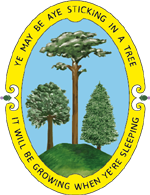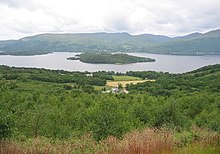
Sir Dietrich Brandis was a German-British botanist and forestry academic and administrator, who worked with the British Imperial Forestry Service in colonial India for nearly 30 years. He joined the British civil service in Burma in 1856, shortly afterwards became head of the British forestry administration in all of Burma, and served as Inspector General of Forests in India from 1864 to 1883. He returned to Europe in 1883, dividing his time between Bonn and Greater London. In retirement he dedicated himself to scholarly work, resulting in the book Indian Trees (1906), his magnum opus. Brandis is considered the father of tropical forestry and has also been described as the father of scientific forestry. In addition to his work in India, he also had a significant influence on forest management in the United States.
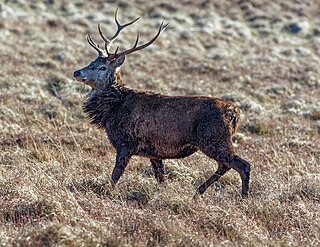
Natural history of Scotland concerns the flora, fauna and mycota of Scotland.
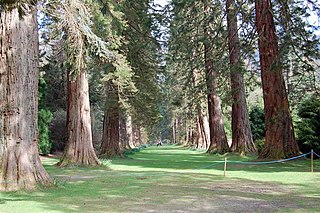
Benmore Botanic Garden is a large botanical garden situated in Strath Eachaig at the foot of Beinn Mhòr, on the Cowal peninsula, in Argyll and Bute, Scotland. The gardens are on the west side of the A815 road from Dunoon, between the Holy Loch and Loch Eck, and include footbridges across the River Eachaig. It is one of the sites of Royal Botanic Garden Edinburgh.
William Hamilton (1669–1732) was a Scottish Presbyterian theologian and minister of the Church of Scotland. He was professor of divinity at the University of Edinburgh from 1709 to 1732 and also principal of the university from 1730 to 1732.
The Royal Forestry Society (RFS) is an educational charity and one of the oldest membership organisations in England, Wales and Northern Ireland for those actively involved in woodland management.
Alexander Gibson (1800–1867) was a Scottish surgeon and botanist who worked in India. He was born in Kincardineshire and studied at Edinburgh. He went to India as a surgeon in the Honourable East India Company. He became a superintendent of the Dapuri botanical gardens (1838-47) under the erstwhile Bombay Presidency.He was appointed as the first Conservator of Forests of India on 22 March 1847. He published several works on botany and reports on forestry in India. He laid a foundation stone of Indian forestry and made a memorable contribution.

Hugh Francis Clarke Cleghorn was a Madras-born Scottish physician, botanist, forester and land owner. Sometimes known as the father of scientific forestry in India, he was the first Conservator of Forests for the Madras Presidency, and twice acted as Inspector General of Forests for India. After a career spent in India Cleghorn returned to Scotland in 1868, where he was involved in the first ever International Forestry Exhibition, advised the India Office on the training of forest officers, and contributed to the establishment of lectureships in botany at the University of St Andrews and in forestry at the University of Edinburgh. The plant genus Cleghornia was named after him by Robert Wight.

The flora of Scotland is an assemblage of native plant species including over 1,600 vascular plants, more than 1,500 lichens and nearly 1,000 bryophytes. The total number of vascular species is low by world standards but lichens and bryophytes are abundant and the latter form a population of global importance. Various populations of rare fern exist, although the impact of 19th-century collectors threatened the existence of several species. The flora is generally typical of the north-west European part of the Palearctic realm and prominent features of the Scottish flora include boreal Caledonian forest, heather moorland and coastal machair. In addition to the native species of vascular plants there are numerous non-native introductions, now believed to make up some 43% of the species in the country.
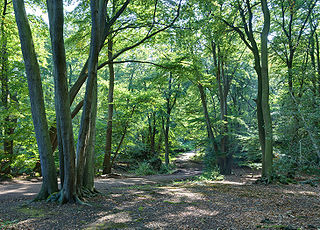
The United Kingdom, being in the British Isles, is ideal for tree growth, thanks to its mild winters, plentiful rainfall, fertile soil and hill-sheltered topography. In the absence of people, much of Great Britain would be covered with mature oaks, except for Scotland. Although conditions for forestry are good, trees face threats from fungi, parasites and pests. Nowadays, about 13% of Britain's land surface is wooded. European countries average 39%, but this varies widely from 1% (Malta) to 66% (Finland). As of 2021, government plans call for 30,000 hectares to be reforested each year. Efforts to reach these targets have attracted criticism for planting non-native trees, or trees that are out of place for their surroundings, leading to ecological changes.

Scotland is ideal for tree growth, thanks to its mild winters, plentiful rainfall, fertile soil and hill-sheltered topography. As of 2019 about 18.5% of the country was wooded. Although this figure is well below the European Union (EU) average of 43%, it represents a significant increase compared to the figure of 100 years previously: in 1919 it was estimated that only 5% of the country's total land area was covered in forest. The Scottish Government's Draft Climate Change Plan has set an aim of increasing coverage to 21% of Scotland by 2032, with the rate of afforestation rising to 15,000 hectares per year by 2024.
Sir Hugh Cleghorn FRSE LLD (1751-1836) was the first colonial secretary to Ceylon. He was key in the takeover of Ceylon from Dutch control to the British Empire. In 1795 Cleghorn used his friendship with Comte Charles-Daniel de Meuron, who owned a regiment of Swiss mercenaries, the Regiment de Meuron, that controlled Ceylon for the Dutch, to transfer control to the British. His grandson Hugh Francis Clarke Cleghorn was instrumental in the foundation of the forest department and forest conservation in India.

Cleghornia is a genus of plants in the family Apocynaceae. It includes two species, which are native to Borneo, China, Laos, Malaysia, Sri Lanka, Thailand, and Vietnam.

John Croumbie Brown was a prolific author, minister of religion, forestry pioneer in South Africa as well as soil conservationist and hydrologist. He was the grandson of John Brown (1722-1787), the renowned Scottish theologian and author.
Since 2017, the Woodland Trust has led 70 United Kingdom organizations in the call for a Charter for Trees, Woods and People.

Puck's Glen is a river-formed ravine on the Cowal peninsula in Argyll and Bute, Scotland, with a popular scenic walking trail beside the Eas Mòr stream. In 2020 the glen and adjoining trails were closed temporarily due to COVID-19 restrictions, issues of stability of the gorge, and felling of trees infected by larch disease.
John Ednie Brown, (1848–1899) J.P., F.L.S., was an author on sylviculture and state conservator of forests.
Andrew Watt FRSE (1869–1929) was a 19th/20th-century meteorologist who worked in and helped to develop the Scottish Meteorological Society and the Royal Meteorological Society.
Ted Green MBE is a British academic, scientist, campaigner and arboriculturist. He has been working in a career bridging forestry and conservation for over 50 years, founding the Ancient Tree Forum in 1993. He is described as "Britain's foremost ancient tree expert". He won the Royal Forestry Society's (RFS) Gold Medal for Distinguished Services to Forestry in 2017.
Afforestation efforts in Scotland have provided an increase in woodland expansion. By the 20th century mark, Scotland had diminished woodland coverage to 5% of Scotland's land area. However, by the early 21st century, afforestation efforts have increased woodland coverage to 17%. The Scottish government released their Draft Climate Change Plan in January 2017. The 2017 draft plan has increased the targeted woodland coverage to 21% by 2032 and increases the afforestation rate to 15,000 hectares per year.
Frederick Bailey FRSE FRSGS was a British Army officer serving in the Royal Engineers who headed the Indian Imperial Forestry Service, in charge of overseeing the cultivation and export of timber to the British Empire.
